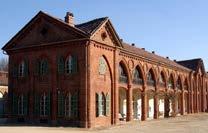
3 minute read
THE ROYAL RESIDENCES
In addition to offering an overview of oldenday court life, the Regge Sabaude testify to the modern history of Piedmont and Italy.
BY GIULIA MINERO
Advertisement
Palazzina di Caccia di Stupinigi
The royal residences are easily accessible by bus or car from Turin, and are among some of the best-preserved examples of 17th and 18th century European architecture. They are a living testimony to the prestige of the local monarchy, the Savoy family, the first kings of unified Italy. In addition to Castello del Valentino and Villa della Regina (see Top in Town), the favourite city-based residences of duchesses and princesses, and the fortress of Castello di Moncalieri, the Regge Sabaude complex, listed as a UNESCO World Heritage site in 1997, includes hunting lodges and country residences, embellished with gardens that reflect the sophistication of courtly life.

PALAZZINA DI CACCIA DI STUPINIGI
Stupinigi was built in Baroque style in 1729, and is only 10km as the crow flies from Piazza Castello. In addition to being used for long hunting expeditions in the company of members of the local aristocracy, Stupinigi was often chosen by members of the Savoy household for celebrations and dynastic weddings.

© CLAUDIO DIVIZIA/SHUTTERSTOCK.COM
Reggia di Venaria Reale
At the beginning of the 20th century, Queen Margherita of Savoy took up residence here. In 1919, Stupinigi became the headquarters of the Furniture Museum, and a space for events and concerts. In addition to its original furnishings and paintings, the museum hosts several masterpieces of cabinetry. The lodge’s beautifully manicured French gardens and internal spaces are open for public viewing, while its historic park is closed to the public.
REGGIA DI VENARIA REALE
Located inside the Park of La Mandria, in the historic centre of the town of Venaria, the Reggia di Venaria Reale is a Baroque-style complex built in the mid-17th century as a glorified hunting lodge for Carlo Emanuele II. Its present-day appearance is the result of work by several prominent architects of the era, including Amedeo di Castellamonte, Michelangelo Garove and lastly Filippo Juvarra, who designed many of its most beautiful

and widely photographed spaces, including the Grand Gallery, the Chapel of Saint Hubert and the imposing 18th-century complexes of the Juvarra Stables and the Citroniera (Orangerie), now used to host exhibitions and events. Inside the Reggia di Venaria Reale, multimedia installations enable visitors to reconstruct the history of court life, while the apartments of King Vittorio Emanuele II of Savoy and his wife Rosa Vercellana, remodelled in the adjacent Castello della Mandria, are open for public viewing, as is the room hosting the collection of royal jewels. On the last floor of the palace, above the monumental corridor known as the Galleria di Diana, discerning diners can enjoy a delightful meal at the Dolce Stil Novo alla Reggia, the Reggia’s Michelinstarred restaurant. www.lavenaria.it
Giardini Reggia di Venaria Reale

CASTELLO DI RIVOLI
Established as a military fortress in 1247, the Rivoli Castle was the first residence of the Savoy duchy. During the 17th century, it was converted into an aristocratic residence, and enlarged with the addition of a wing known as the Manica Lunga, with the ducal picture gallery. Its imposing spaces are now the headquarters of a Museum of Contemporary Art, which also hosts temporary exhibitions. The courtyard of the castle is also home to Combal. Zero, a contemporary starred restaurant whose panoramic glass walls offer glorious views across the countryside as well as the surrounding castle. www.castellodirivoli.org
© OLGYSHA/SHUTTERSTOCK.COM
Castello di Rivoli

THE ROYAL VILLAS
With the trend for holidays, the Royal House of Savoy spends long periods in welcoming country residences surrounded by greenery. In fact, the Royal Apartments of Borgo Castello are located within La Mandria Park, while Racconigi Castle, officially established as a holiday residence, opens onto the town and the extraordinary romantic park, which includes greenhouses and now also a nature reserve. For the same purpose, at the end of the eighteenth century the castles of Govone and Agliè were purchased and in the nineteenth century the Tenuta Reale di Pollenzo, now the seat of the University of Gastronomic Sciences. www.residenzereali.it
Castello di Moncalieri Castello della Mandria

Castello di Agliè Castello di Rivoli (Manica Lunga)










